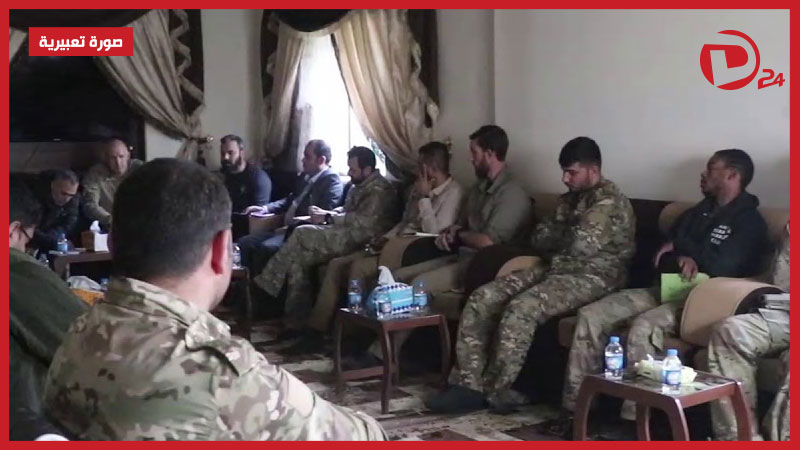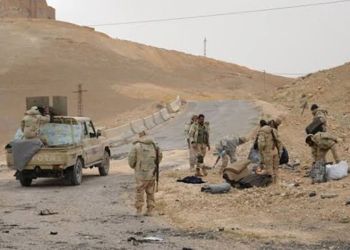This post is also available in:
![]() العربية
العربية
To prevent the two rivals from expanding their influence in east Syria, the coalition needs to exploit their simmering disunity, empower its partners on the ground, and establish stronger ties with select tribal and community leaders.
Both recently and in past months, Iranian and Russian forces in east Syria have taken steps that say more about their rivalry with each other than any desire to confront U.S.-led forces in the area. Two spheres of influence have formed on the west side of the Euphrates River: the northern part of Deir al-Zour province is run by elements of Bashar al-Assad’s army—the 4th Division and the Russian-controlled 5th Corps—while the southern areas of Mayadin and al-Bukamal are increasingly dominated by Iranian forces and their Shia militia proxies. If the United States withdraws more troops from east Syria, this Iranian-Russian rivalry could spill over into armed confrontations and a race to monopolize the “spoils of war” across the river—though it is unlikely to affect their mutual interest in keeping the Assad regime intact.
THE RACE FOR DEIR AL-ZOUR
In August 2017, various actors simultaneously made their way toward Deir al-Zour province in order to eliminate the Islamic State’s local “caliphate” and increase their respective areas of control. The U.S.-led coalition waged its battle east of the Euphrates, while Russia, Iran, and the Assad regime advanced from the west.
As this campaign progressed, the regime began to reassert authority over administrative affairs in Deir al-Zour through its Air Force Intelligence Directorate, military police, local/national defense organs, and the militia Liwa al-Quds. Yet its efforts to establish control on the ground were limited—instead, its irregular National Defense Forces were permitted to run rampant over the area, committing war crimes and human rights abuses while looting and seizing civilian property.
When the Islamic State lost its last bit of territory in March 2019, the regime’s position in the area remained weak, particularly with Assad’s forces still focused on the Idlib front in west Syria. Consequently, a space emerged for Iranian-Russian competition over resources and land in the east.
Earlier this summer, Tehran seemed to gain the upper hand in this competition due to various maneuvers by regime and Russian forces. In July, Damascus withdrew the 4th Division from its headquarters in Mayadin and transferred the 5th Corps out of Deir al-Zour province entirely, transferring them to the Raqqa area. Government forces apparently intend to leave most parts of Deir al-Zour in the coming months and concentrate in major towns. Although Assad does not want to lose influence in the province, he seems to be postponing his ultimate goal of returning in full force due to realities on the ground—namely, the need to keep his main military units focused on the eventual final battle for Idlib, and the fact that his fragile forces in the east are financially backed by both Russia and Iran and therefore divided in their loyalties.
GROWING IRANIAN DOMINANCE
Deir al-Zour is key terrain for Iran. Through its Islamic Revolutionary Guard Corps (IRGC), Tehran has sought to embed itself in the area and recruit young locals to its side by providing material inducements and humanitarian aid, including medical, educational, and cultural services. In particular, it has attempted to woo Shia Muslims living in this predominantly Sunni area. Thousands of locals have been recruited to militias in this manner, and Iran’s proselytizing activities in the province continue to expand. To attract elite support and win further hearts and minds among local youths, Tehran financially supports community dignitaries and leaders from the Baggara tribe and the “Tribal Army” militia. In return, these figures often provide intelligence and security support that facilitates the movements of Iranian forces and proxies.
Iran’s deep interest in this area stems from its desire to link up activities and networks stretching from Iraq to the Syria border town of al-Bukamal and all the way west to Lebanon. To help fund its operations in Syria, Iran smuggles weapons, drugs, and tobacco on both sides of the Iraqi frontier. Its Syrian presence is robust even in areas where U.S. troops are positioned—for instance, the largest contingent of Iranian personnel and militias in Deir al-Zour is on a direct line of contact with American forces that control the nearby Conoco oil field. In all, nearly one thousand Iranian fighters are positioned in Deir al-Zour in addition to a few hundred other foreign militia fighters from Iraq and Afghanistan.
Iran has also sought to win over tribal and community leaders in areas on the east side of the river controlled by the U.S.-backed Syrian Democratic Forces (SDF). Such efforts accelerated after the assassination of tribal notables—especially when Sheikh Mutashar al-Hafel and a companion from the al-Ougaidat clan were killed in early August, sparking demonstrations against the SDF.
RUSSIA BALANCING INTERESTS
Following the Islamic State’s territorial collapse, Russia hurried to control portions of Deir al-Zour west of the Euphrates, including several villages where Iran’s IRGC and Shia militia forces are active. Its main priority has been to secure strategic sites such as the military airport, which supplements its presence at airports/bases in other parts of Syria (e.g., Abu Duhur, Hmeimim, and Qamishli).
Russia has not fully resisted the growth of Iranian power in Deir al-Zour, probably to postpone internal conflicts in its axis with Damascus and Tehran. Yet there are signs of potential confrontation on the horizon. In exchange for its services as “savior” of the Assad regime, Russia is pursuing a long-term campaign to expand its influence in Syria, and it often portrays Iran’s presence and activities as subsumed under this campaign. In April, Russia conducted a patrol in Mayadin, apparently to signal Iranian militias that it seeks to control oil resources south of the town such as al-Ward field. Moscow also aims to contain Tehran’s influence further south in al-Bukamal, where proxy fighters from Liwa Fatemiyoun and Kataib Hezbollah are plentiful.
Such tensions could morph into active conflict in the future—and may have already. According to local activists and tribal leaders, Iran has accused Russia of bombing its military headquarters and positions in al-Bukamal. Meanwhile, Russian and Iranian positions in Deir al-Zour have been hit by several unclaimed attacks, creating mistrust between the two sides. Moscow’s suspicions began to emerge as early as 2017, when prominent Russian-backed generals in the Syrian military were targeted (e.g., Issam Zahreddine and Suhail “The Tiger” al-Hassan).
Further exacerbating these tensions is Israel’s continued campaign of military strikes against Iranian and Lebanese Hezbollah targets in Syria. Iran still has relatively free rein in Deir al-Zour, and its ambitions there have not diminished, but numerous strikes on its forces and proxies have forced it to change positions at times and bear significant military costs. Russia has the capacity to prevent these Israeli strikes if it so desired but has turned a blind eye to them instead, possibly in order to weaken Iran’s influence. Whatever its intentions, Moscow’s inaction on this front has increased tensions with Tehran.
Another potential provocation is Russia’s recent attempt to attract Syrian fighters from Iranian ranks through financial inducements. Due in part to U.S. sanctions, Tehran cannot pay attractive salaries to these militia members—the highest local rate is around 80,000 Syrian pounds per month, or less than $50 USD (note that official Syrian conversion rates tend to be inaccurate because the regime does not want to show how low the pound has fallen; the above figure is based on conversations with locals).
POLICY IMPLICATIONS
The U.S. coalition east of the Euphrates is arguably disregarding important developments led by America’s rivals on the other side of the river. This is a mistake, since both Russia and Iran seek to cultivate greater ties with locals and eventually expand their presence eastward.
To prevent this outcome, the United States should exploit the simmering disunity between Tehran and Moscow. This includes helping the SDF and tribal allies block Iranian infiltration east of the Euphrates by enforcing robust security measures. Coalition officials and their partners on the ground should also draw closer to community and tribal leaders who do not have sectarian or political loyalties to Iran. Without such measures, any U.S. withdrawal would allow Russia and Iran to quickly expand their presence in the east—and, in the process, generate more opportunities for the Islamic State to recruit new cadres and rebuild its insurgency.
By Oula A. Alrifai and Ali Alleile, The Washington Institute












